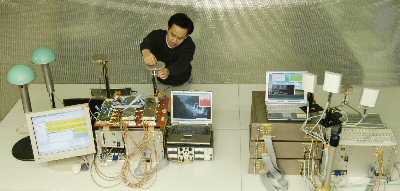For the first time, data were transferred in real time via mobile communication at a speed of one gigabit per second (Gbit/s); that equates to 1,000 megabits per second (Mbit/s) . By comparison: WLAN networks presently offer the fastest wireless links to mobile devices at speeds of around 50 MBit/s . In order to achieve its record-setting high speed, Siemens combined an “intelligent antenna system” consisting of three transmitting and four receiving antennas with Orthogonal Frequency Division Multiplexing (OFDM) . Researchers consider these technologies, which are especially efficient at using the frequently band, to be highly promising modules for the mobile communication generation beyond W-CDMA.
By the time the next generation of mobile communication debuts, which is expected to occur beginning in the year 2015, the need for transmission capacities for voice, data, image and multimedia is conservatively anticipated to rise by a factor of 10. “Future mobile communication systems will have to utilize the frequency band as efficiently as possible, with the lowest possible transmit power,” said Christoph Caselitz, the President of the Mobile Networks Division at Siemens Communications . “With our experimental system, we’ve been able to demonstrate how powerful intelligent antennas can be in combination with OFDM. In doing so, we’ve created a major module for future mobile communication systems.”
Professionals term intelligent antenna systems “multiple-antenna systems” or “MIMO” (Multiple Input, Multiple Output) systems. Under this concept, multiple antennas simultaneously transmit different flows of data over one and the same radio channel and frequency band. This is comparable to a room in which multiple clusters of people are simultaneously conducting conversations both within each cluster and between clusters, yet without interfering with one another. In contrast to conventional individual antennas, which each transmit on a separate frequency, the MIMO method enables data rates to be multiplied by making significantly more efficient use of the costly frequency band resource.
One of the reasons why multiple-antenna systems are not typically used today is the very high computing power that is required at the receiving end. This is because the information that is transmitted simultaneously by multiple antennas is received by multiple receiving antennas and has to be reconstructed in realtime for the receiving device. This exceeds the capabilities of the typical chips that are currently being employed in the mobile communication industry. The researchers at Siemens overcame this challenge by developing new and optimizing signal processing algorithms that can be efficiently implemented on the hardware modules that are available today.
The experimental system operates in the 5-GHz band and has a bandwidth of 100 MHz. The Orthogonal Frequency Division Multiplexing (OFDM) transmission method that it employs protects the signals against most types of interference, such as the echoes that are produced when the signals reflect off buildings. This method, which has long been known and is considered to be a highly promising transmission technology for future mobile communication, is already being employed today in Wireless LAN as well as in digital television (DVB) and radio (DAB).
The Siemens research team is already working on further increasing the data rate and enhancing the mobility of devices equipped with multiple antennas.
Siemens developed the experimental one-gigabit transmission system, which will premiere to the general public at the 3GSM World Congress 2005 in Cannes , in collaboration with the Fraunhofer Institute for Telecommunications (Heinrich Hertz Institute) and the Institute for Applied Radio System Technology .












 RSS feed
RSS feed